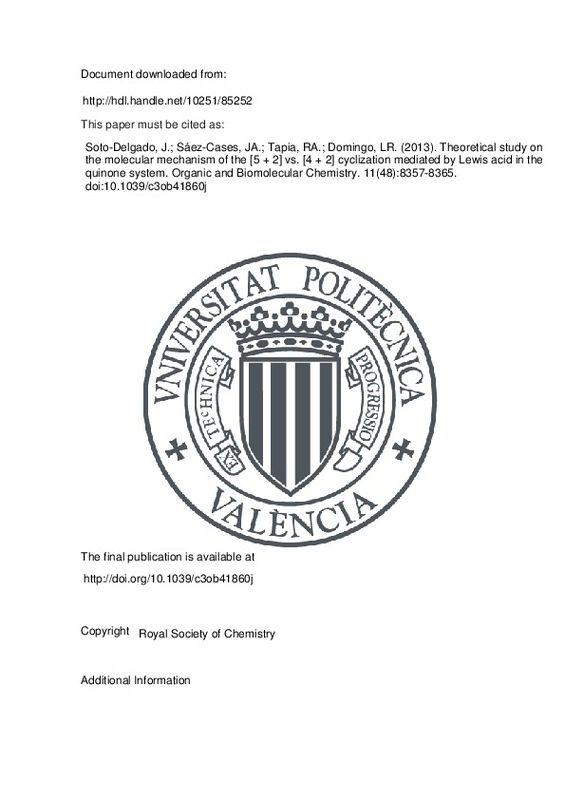JavaScript is disabled for your browser. Some features of this site may not work without it.
Buscar en RiuNet
Listar
Mi cuenta
Estadísticas
Ayuda RiuNet
Admin. UPV
Theoretical study on the molecular mechanism of the [5 + 2] vs. [4 + 2] cyclization mediated by Lewis acid in the quinone system
Mostrar el registro sencillo del ítem
Ficheros en el ítem
| dc.contributor.author | Soto-Delgado, Jorge
|
es_ES |
| dc.contributor.author | Sáez-Cases, José Antonio
|
es_ES |
| dc.contributor.author | Tapia, Ricardo A.
|
es_ES |
| dc.contributor.author | Domingo, Luis R.
|
es_ES |
| dc.date.accessioned | 2017-07-17T10:41:27Z | |
| dc.date.available | 2017-07-17T10:41:27Z | |
| dc.date.issued | 2013-10-28 | |
| dc.identifier.issn | 1477-0520 | |
| dc.identifier.uri | http://hdl.handle.net/10251/85252 | |
| dc.description.abstract | [EN] The thermal and Lewis acid (LA) catalyzed cyclizations of quinone 1 involved in the synthesis of Colombiasin A and Elipsaterosin B have been theoretically studied using DFT methods at the B3LYP/6-311G(d,p) computational level. B3LYP calculations suggest that the formal endo [4 + 2] cycloadduct allowing the synthesis of Colombiasin A is preferentially formed under thermal conditions, while in the presence of the BF3 LA catalyst the formal [5 + 2] cycloadduct is seen, allowing the synthesis of Elipsaterosin B. The BF3 LA catalyst not only accelerates the nucleophilic attack on the C2 carbon of the quinone framework through a more polar C-C bond formation, but also provokes a different electron density rearrangement along the nucleophilic attack favoring the subsequent C-C bond formation at the C4 carbon with the formation of the formal [5 + 2] cycloadduct. ELF bonding analysis along these cyclizations indicates that the C-C single bond formation takes place in the range of 1.91-2.1 angstrom by C-to-C coupling of two pseudoradical centers. Along the formation of the first C2-C9 single bond, these pseudoradical centers appear at one of the most electrophilic and at one of the most nucleophilic centers of quinone 1, C2 and C9 carbons, respectively. Analysis of the Parr functions suggests that although the most favorable electrophilic/nucleophilic interaction is that involving the C2 carbon of quinone and the C12 carbon of the butadiene framework, the intramolecular nature of the cyclization prevents the corresponding reactive channel. | es_ES |
| dc.description.sponsorship | This work was supported by the Post-Doctoral fellow FONDECYT Grant 3130359 and Project ICM-P10-003-F CILIS granted by Fondo de Innovacion para la Competitividad del Ministerio de Economia, Fomento y Turismo, Chile. | |
| dc.language | Inglés | es_ES |
| dc.publisher | Royal Society of Chemistry | es_ES |
| dc.relation.ispartof | Organic and Biomolecular Chemistry | es_ES |
| dc.rights | Reserva de todos los derechos | es_ES |
| dc.subject | Electron localization function | es_ES |
| dc.subject | Polarizable continuum model | es_ES |
| dc.subject | Diels-alder reaction | es_ES |
| dc.subject | Topological analysis | es_ES |
| dc.subject | Bond formation | es_ES |
| dc.subject | Elf analysis | es_ES |
| dc.subject | Cycloaddition reaction | es_ES |
| dc.subject | (-) Elisapterosin-B | es_ES |
| dc.subject | (-) Colombiasin-A | es_ES |
| dc.title | Theoretical study on the molecular mechanism of the [5 + 2] vs. [4 + 2] cyclization mediated by Lewis acid in the quinone system | es_ES |
| dc.type | Artículo | es_ES |
| dc.identifier.doi | 10.1039/c3ob41860j | |
| dc.relation.projectID | info:eu-repo/grantAgreement/FONDECYT//ICM-P10-003-F/ | es_ES |
| dc.relation.projectID | info:eu-repo/grantAgreement/FONDECYT//3130359/CL/THEORETICAL STUDY OF THE HETERO-DIELS-ALDER REACTIONS IN DIFFERENT REACTIONS MEDIA/ | |
| dc.rights.accessRights | Abierto | es_ES |
| dc.contributor.affiliation | Universitat Politècnica de València. Instituto Universitario Mixto de Tecnología Química - Institut Universitari Mixt de Tecnologia Química | es_ES |
| dc.description.bibliographicCitation | Soto-Delgado, J.; Sáez-Cases, JA.; Tapia, RA.; Domingo, LR. (2013). Theoretical study on the molecular mechanism of the [5 + 2] vs. [4 + 2] cyclization mediated by Lewis acid in the quinone system. Organic and Biomolecular Chemistry. 11(48):8357-8365. https://doi.org/10.1039/c3ob41860j | es_ES |
| dc.description.accrualMethod | S | es_ES |
| dc.relation.publisherversion | http://doi.org/10.1039/c3ob41860j | es_ES |
| dc.description.upvformatpinicio | 8357 | es_ES |
| dc.description.upvformatpfin | 8365 | es_ES |
| dc.type.version | info:eu-repo/semantics/publishedVersion | es_ES |
| dc.description.volume | 11 | es_ES |
| dc.description.issue | 48 | es_ES |
| dc.relation.senia | 256844 | es_ES |
| dc.identifier.eissn | 1477-0539 | |
| dc.identifier.pmid | 24170110 | |
| dc.contributor.funder | Fondo Nacional de Desarrollo Científico y Tecnológico, Chile | |
| dc.contributor.funder | Ministerio de Economía, Fomento y Turismo, Chile |







![[Cerrado]](/themes/UPV/images/candado.png)

